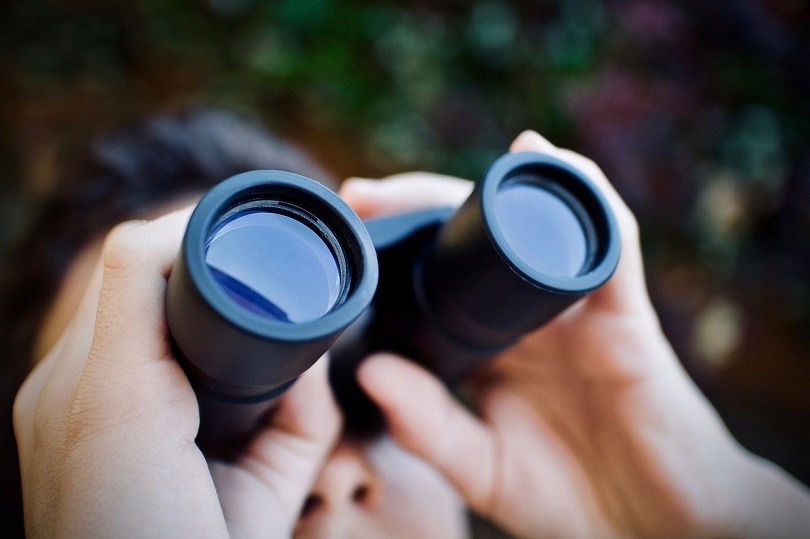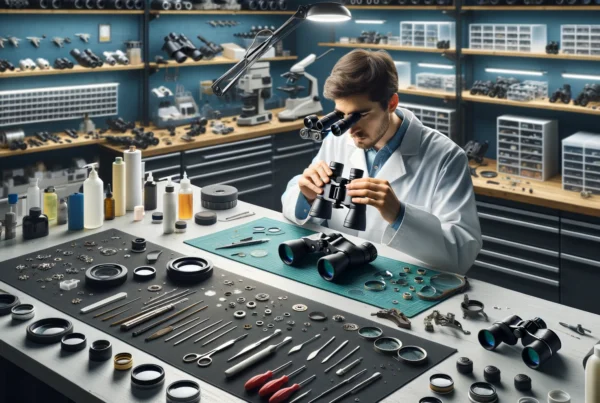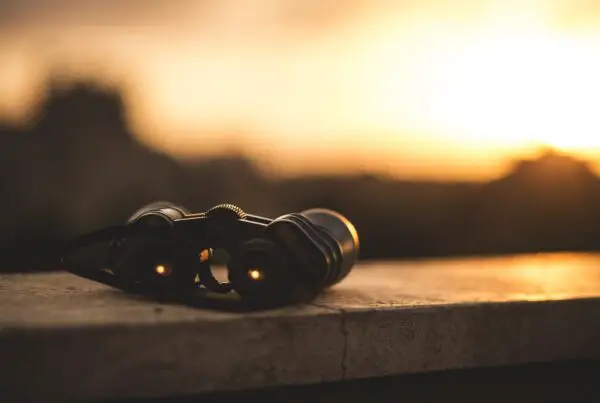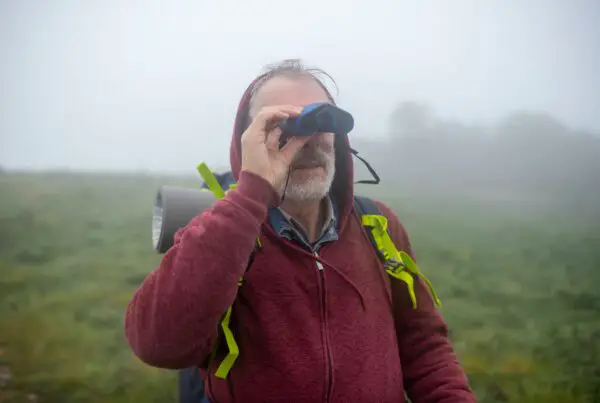Contents
- An Optics Odyssey
- Revealing the Secrets of Specifications:
- Calculating Theoretical Vision Range:
- For Astronomy Binoculars
- For Birdwatching Binoculars
- For Hunting Binoculars
- For Marine Binoculars
- For Travel Binoculars
- For Sports and Outdoor Events
- For Long-Distance Landscape Observation:
- Factors Affecting Vision Range
- Tips for Maximizing Vision Range
- Frequently Asked Questions (FAQ’s)
- To Conclude
While there is no limit to how far you can see with binoculars, how well you can resolve that faraway object is something different. The range of binoculars depends on their magnification, objective lens diameter, and other factors.
In this article, we will discuss different types of binoculars for different aspects and explain how to choose the best binoculars for your needs.
An Optics Odyssey
Binoculars, those familiar handheld wonders, are more than just instruments; they’re gateways to exploration. But as we lift them to our eyes, a question often lingers: How far can you truly see with these binoculars? The answer, my friend, lies in the delicate interplay of science, technology, and nature.
Revealing the Secrets of Specifications:
Unlocking the potential of binoculars starts with understanding their specifications. Two numbers engraved on the device – magnification and objective lens diameter – hold the key.
Magnification
Magnification, represented by the first number, determines how much closer the object appears. However, a higher magnification isn’t always the ideal choice, as it narrows the field of view and can be prone to shaking without proper stabilization.
Objective Lens Diameter
The second number, the objective lens diameter, influences how much light enters the binoculars. It’s the reason a 10×50 pair seems bulkier than a 10×25 – because the larger diameter allows more light to paint the scene, resulting in brighter images, especially in dim conditions.
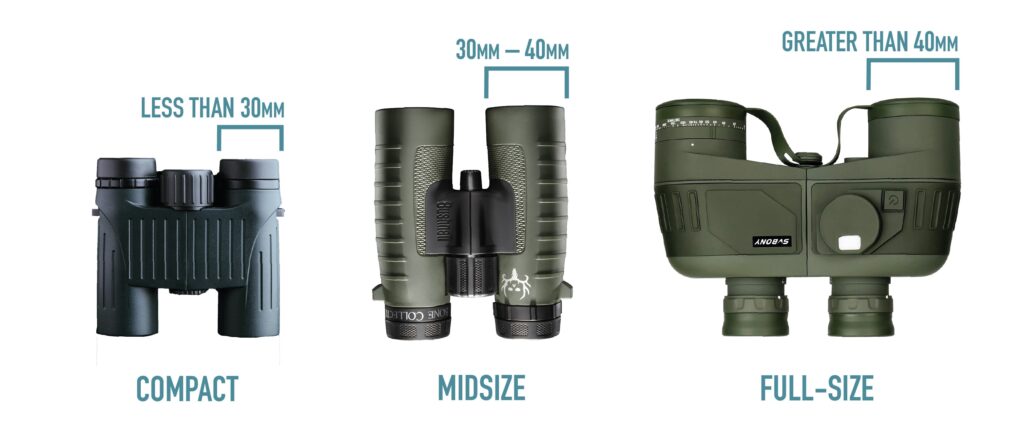
Calculating Theoretical Vision Range:
But let’s get to the heart of the matter – the range. Ever wondered how we can calculate the potential distance binoculars can cover? The formula reads like poetry:
Range = 1.22 * (Objective Lens Diameter) * (Angular Field of View) / (Exit Pupil Diameter).
The exit pupil diameter? It’s the magic number that decides how much light reaches your eyes.
To put this into perspective, let’s consider different scenarios and the binoculars best suited for them:
For Astronomy Binoculars
Binoculars dedicated to astronomy must have certain features. The best stargazing binoculars will feature big objective lenses (the end aimed at the stars) to allow as much dim starlight as possible through to the observer’s eyes. They will also offer generous magnification to enlarge those small pinpricks of light from deep in the cosmos.
As a rule of thumb, get stargazing binoculars with an aperture of 35 mm to 60 mm aperture and a magnification of 7x to 10x. A pair of 7×35’s is ideal for beginners.
Here are some of the best binoculars for astronomy:
- Helios Stellar II Binoculars
- Celestron SkyMaster Giant 15×70 Binoculars
- Orion Scenix 7×50 Binoculars
- Nikon Aculon A211 10-22×50 Binoculars
- Vortex Optics Viper HD Binoculars
For Birdwatching Binoculars
Most birders prefer 7- or 8-power binoculars because they’re bright and have a wide field of view, making it easier to find birds and to follow them in flight. Binoculars with 40 mm, 42 mm, or 44 mm objectives serve as a good medium compromise between low-light capability and portability.
Objectives smaller than 35 mm will lead to a more limited field of view, while objectives larger than 50 mm will result in a heavier and bulkier pair of binoculars.
Here are some of the best binoculars for birdwatching:
- Vortex Optics Viper HD Binoculars
- Nikon Monarch 5 Binoculars
- Celestron Nature DX ED Binoculars
- Swarovski EL Binoculars
- Zeiss Victory SF Binoculars
For Hunting Binoculars
When it comes to hunting, binoculars are an essential tool for spotting game from a distance. The most powerful binoculars are not always the best option. Sometimes it is better to hold back a bit as there are many other important factors to consider when choosing the best.
For close quarters and archery hunting, a pair of 8×42’s will be sufficient for most situations. For spot and stalk tactics, higher magnifications will yield better results. 10×42 or 12×50 binoculars mounted on a tripod are a great route. Here are some of the best binoculars for hunting:
- Vortex Optics Viper HD Binoculars
- Leupold BX-5 Santiam HD Binoculars
- Swarovski SLC Binoculars
- Zeiss Victory SF Binoculars
- Maven B.6 Binoculars
For Marine Binoculars
Marine binoculars are designed to withstand the harsh conditions of the sea, including saltwater, fog, and rough handling. They are also waterproof and buoyant, making them easy to retrieve if dropped overboard.
Marine binoculars typically have a magnification of 7x or 8x and an objective lens diameter of 30 mm to 50 mm. A magnification of 7x or 8x is ideal for marine use because it provides a wide field of view and is less prone to image shake.
Here are some of the best binoculars for marine use:
- Steiner Navigator Pro Binoculars
- Fujinon Mariner Binoculars
- Nikon OceanPro Binoculars
- Bushnell Marine Binoculars
- Vortex Optics Kaibab HD Binoculars
For Travel Binoculars
When traveling, binoculars can be a great tool for sightseeing, birdwatching, and exploring nature. However, they need to be lightweight and compact enough to carry around all day.
Look for binoculars with a magnification between 8x–12x, a wide field of view, and a close focusing distance. A magnification of 8x – 10x should work well for wildlife viewing in forested areas, while 8x – 12x are ideal for lakes and tidelands.
Here are some of the best binoculars for travel:
- Nikon Monarch 5 Binoculars
- Vortex Optics Diamondback HD Binoculars
- Celestron Nature DX ED Binoculars
- Swarovski CL Pocket Binoculars
- Zeiss Terra ED Binoculars
For Sports and Outdoor Events
When the game is on or a concert beckons, a pair of 10×25 compact binoculars steps into the spotlight. With a potential range of approximately 300–400 yards, these binoculars ensure you don’t miss a moment of the action, allowing you to revel in the excitement from a distance.
Here are some of the best binoculars for sports & outdoor events:
- Nikon ACULON A211 10-22×50 Zoom Binocular
- Binoteck 12×42 Binoculars
- Hawke Sport Optics 8×42 Endurance ED
- Carson 3D Series High Definition Compact & Waterproof Binoculars
- Occer compact binoculars
For Long-Distance Landscape Observation:
The allure of distant landscapes calls for binoculars with higher magnification, such as 20×60. With a theoretical range surpassing 1500 yards, these binoculars enable you to explore the intricate details of sprawling vistas, from mountain ranges to valleys, capturing the essence of the horizon’s grandeur.
Here are some of the best binoculars for long-distance landscape observation:
- Nikon Aculon 16×50 Binoculars
- Celestron 71017 SkyMaster 25×100
- Celestron UpClose G2 10-30×50
- Ronhan High Power 20×50
- Adasion 12×42
Factors Affecting Vision Range
While the theoretical calculations provide a foundation, the real world brings its complexities. Atmospheric conditions, such as haze, humidity, and air pollution, can impact visibility, altering the effective range.
Furthermore, the quality of binoculars, encompassing aspects like lens coatings and image stabilization technology, plays a pivotal role in actual vision range.
Tips for Maximizing Vision Range
To maximize the potential of your binoculars’ vision range, consider these practical pointers:
- Select binoculars with specifications tailored to your intended use.
- Opt for higher-quality optics and coatings to enhance image clarity.
- Choose binoculars with a wider field of view for tracking moving subjects.
- Utilize a tripod or stable surface to steady your view, particularly at longer distances.
- Opt for optimal viewing conditions by avoiding extreme weather and light pollution.
Frequently Asked Questions (FAQ’s)
Here are some frequently asked questions (FAQs) and answers about using an air fryer for the first time:
How do binocular specifications impact the vision range?
Binocular specifications, such as magnification and objective lens diameter, play a crucial role in determining the potential vision range. Higher magnification brings objects closer but narrows the field of view, while a larger objective lens diameter allows more light, enhancing image brightness and clarity.
How can I calculate the theoretical vision range of binoculars?
The theoretical vision range can be estimated using the formula: Range = 1.22 * (Objective Lens Diameter) * (Angular Field of View) / (Exit Pupil Diameter). The exit pupil diameter influences the amount of light that reaches your eyes and affects the overall range.
Are the calculated ranges always accurate?
The calculated theoretical ranges provide a baseline, but real-world conditions like atmospheric factors (haze, humidity), binocular quality (lens coatings, stabilization), and user stability can affect the actual achievable range.
What are some common uses for different types of binoculars?
Binoculars serve various purposes. Bird watching binoculars with 8×42 specifications are ideal for observing birds in their habitats. Sports and outdoor event binoculars, like 10×25, are perfect for catching action from a distance. Long-distance landscape observation, best achieved with models like 20×60, allows you to appreciate far-reaching vistas.
Can binoculars help with stargazing and astronomy?
Absolutely! Binoculars, particularly those with larger objective lens diameters like 7×50, can enhance your stargazing experience by providing a wider field of view and better image clarity for celestial observations.
How do atmospheric conditions impact vision range?
Atmospheric factors like haze, humidity, and air pollution can hinder visibility, reducing the effective vision range. Clearer weather conditions generally allow for better long-distance viewing.
Do I need to use a tripod for longer distances?
Using a stable platform like a tripod can be beneficial for longer distances. It helps minimize hand tremors and ensures a steadier view, especially when using binoculars with higher magnification.
What’s the importance of lens quality and coatings?
Higher-quality optics and specialized lens coatings can significantly impact image clarity and brightness, allowing for clearer views and potentially extending the effective vision range.
How do I choose the right binoculars for my needs?
Consider your intended use, such as bird watching, sports, or landscape observation. Choose binoculars with appropriate specifications, factoring in magnification, objective lens diameter, and comfort in hand.
What can I do to maximize my binoculars’ vision range?
To maximize your binoculars’ potential:
- Choose binoculars with suitable specifications for your intended use.
- Opt for higher-quality optics and coatings for improved image clarity.
- Select binoculars with a wider field of view for dynamic subjects.
- Use a tripod or stable surface for steadier viewing at longer distances.
- Optimize viewing conditions by avoiding extreme weather and light pollution.
To Conclude
Remember to consider the magnification, effective diameter of the objective lens, exit pupil, real field of view, apparent field of view, field of view at 1,000 meters, eye relief, close focusing distance, and waterproofing when choosing binoculars. With the right pair of binoculars, you can enjoy the great outdoors and all its wonders.

A Binoculars enthusiast, who love exploring skies and watching birds. It is my hobby to collect Binoculars of different kinds and try to explore the world through various lenses. This is all I do to explore happiness by magnifying my beautiful world.

